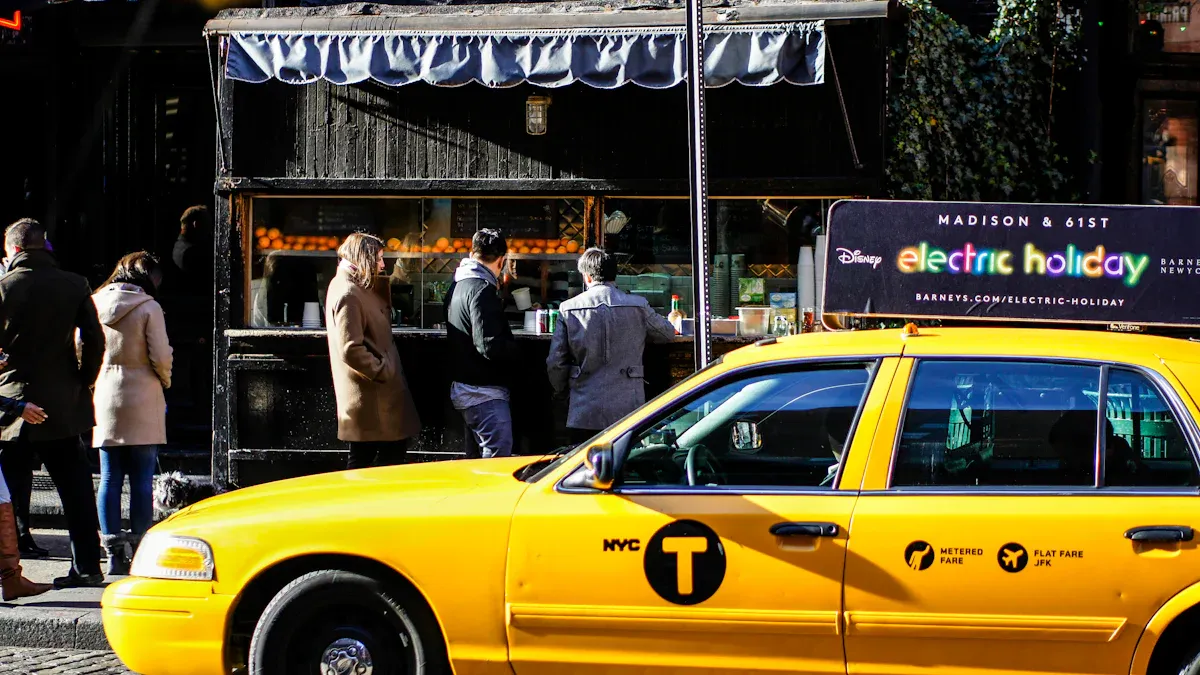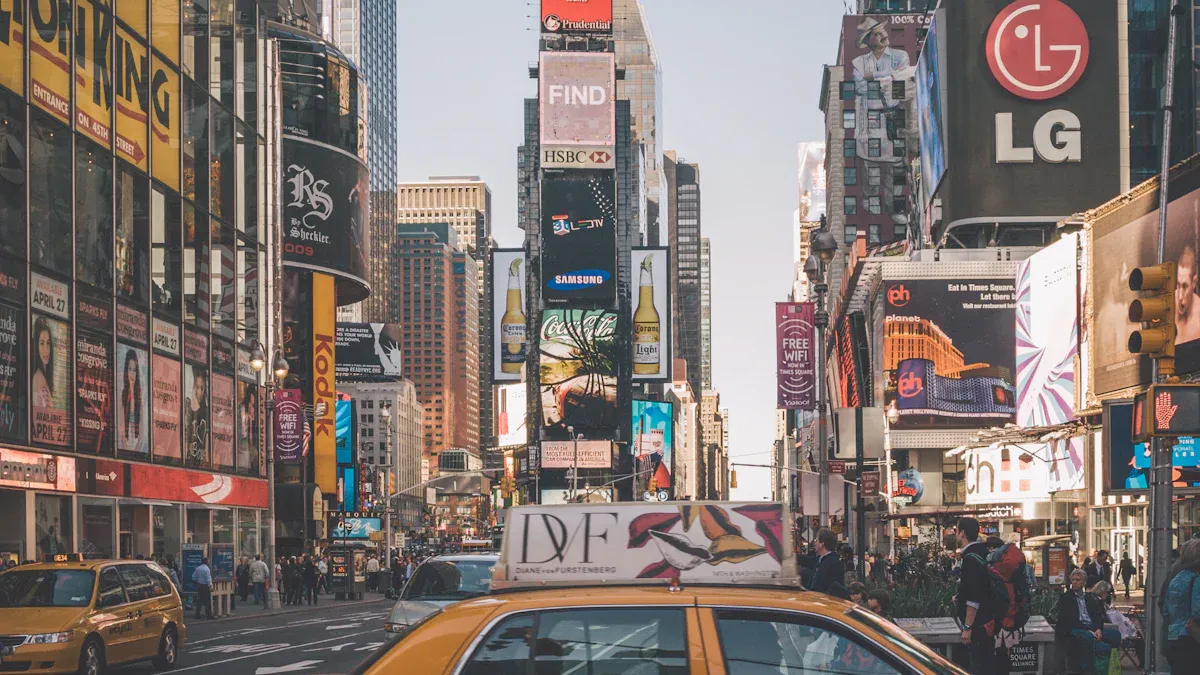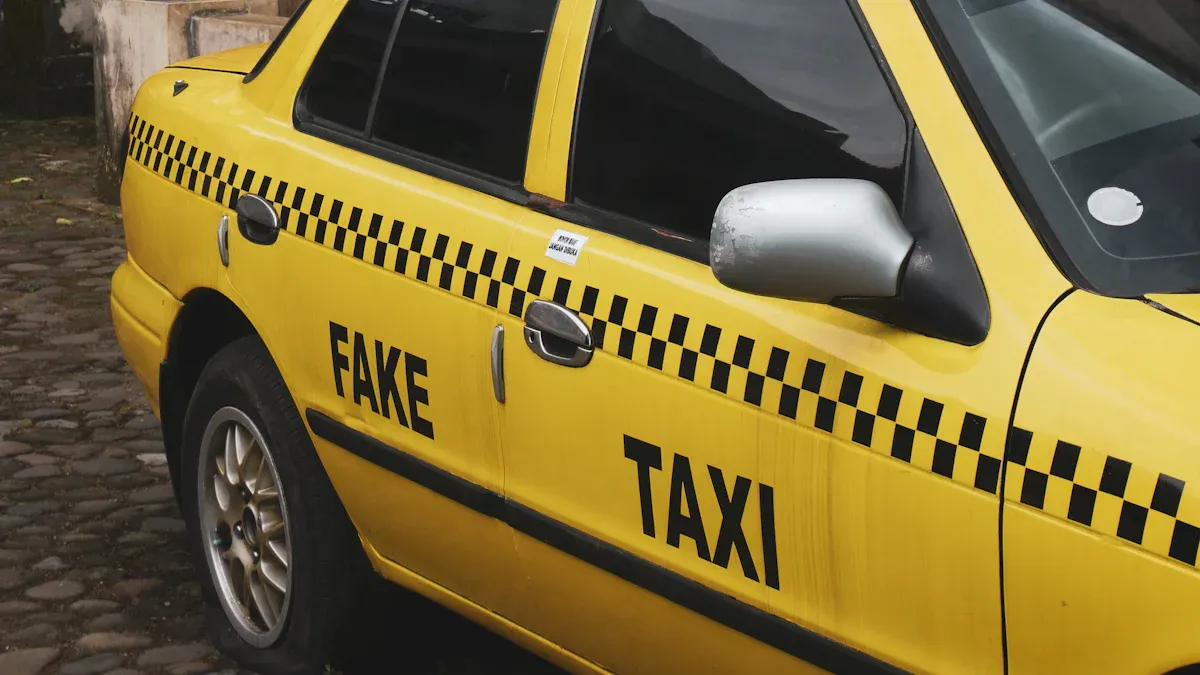
Taxis cover urban areas by traveling all over the city with great reach. They drive on busy streets, quiet areas, and fancy shopping places at any time. Because taxis are always moving, many people see the brands. People like commuters and tourists notice them. Taxi advertising is special because it shows up in busy places and rich neighborhoods. This makes it a good idea for businesses that want everyone to see them.
Key Takeaways
Taxis drive everywhere in the city. They go to busy and quiet places. This helps brands get noticed by many people.
Taxi ads come in different types like taxi tops, full wraps, and inside ads. Each type helps grab people’s attention in a special way.
Taxi advertising lets many people see the ads. It helps brands reach both locals and visitors easily.
Brands can pick certain places and groups to show ads. They use geotargeting and real-time data for this. This helps show the right ad at the right time.
Taxi ads help people remember brands well. People see them a lot and in many places. This makes brands easy to remember.
Taxis Cover Urban Areas

Citywide Presence
Taxis move through all parts of the city. They drive on busy roads, quiet streets, and places where tourists go. Because taxis go everywhere, brands can reach many people. Taxis do not stay in one spot. They pick up and drop off people in business areas, shopping places, and where people live. After each ride, taxis look for new passengers. This means taxis are always moving and showing up in new places.
Taxis go where people need rides. Their routes change during the day. This helps brands reach people in busy and quiet spots.
The table below shows how taxis spread out in the city:
City Zone | Description/Role in Model | Taxi Fleet Distribution and Behavior |
|---|---|---|
Central Business District | Main urban region with high business activity | Taxis pick up people when needed; many rides start or end here during busy times |
Commercial Zone | Area with shops and businesses | Taxis come and go from this area; how many are there changes during the day |
Residential Zone | Neighborhoods where people live | Taxis serve these places; after dropping off, they look for new riders, so taxis spread out |
General Model Behavior | City grid with roads and intersections | Taxis pick up based on who needs a ride; after trips, they move around, so taxis cover many places |
Taxis reach up to 85% of city zones, even fancy and popular places. This helps brands get seen where people live, work, and visit.
High-Traffic Locations
Taxis spend lots of time in busy places. These include airports, train stations, business areas, and city centers. Studies show taxis make millions of trips between these spots. Even when travel changes, like during COVID-19, taxis still show up in these important places.
Taxis work all day and night, so ads on taxis get seen anytime. Because taxis always move, brands can reach many people, like workers, tourists, and business people. Taxis are like moving billboards. Ads do not stay in one place. They travel through neighborhoods and busy areas like Times Square, Wall Street, and Broadway.
Taxis drive around day and night, so brands get seen all the time.
Many taxis in big cities help ads reach millions every day.
Digital taxi tops and screens inside make ads more fun and help more people see them.
Taxis help ads show up in both busy and quiet places. This way, brands get noticed by many different people.
Ad Formats

Taxi advertising uses several formats to help brands reach people in the city. Each format offers different ways to show ads and connect with audiences. The main types include taxi tops, full wraps, and interior ads. These formats give brands a strong presence on city streets and inside vehicles.
Taxi Tops
Taxi tops sit on the roof of the vehicle. They come in two main styles: static and digital. Static taxi tops use backlit signs to display one ad at a time. Digital taxi tops use LED screens to show many ads and can change messages based on time or location. These ads stand out to both drivers and pedestrians.
Taxi top ads create millions of impressions each month. For example, in New York, taxi tops generate about 70 million impressions monthly. In Philadelphia, the number is over 780,000.
City | Average Monthly Impressions from Taxi Top Ads |
|---|---|
New York | 70,000,000 |
Philadelphia | |
Memphis |
Taxi tops give brands high visibility in busy areas. Their bright displays catch attention day and night.
Full Wraps
Full wraps cover the entire taxi with a vinyl ad. This format turns the whole vehicle into a moving billboard. People see the ad from every angle, making it hard to miss. Full wraps work well in crowded city streets and traffic.
A study shows that 96% of people notice vehicle wraps more than billboards. Full wraps also cost less per impression than many other ad types. Brands get strong recall and wide exposure with this format.
Full wraps stand out in traffic.
They reach people walking, driving, or waiting at lights.
Brands can use bold colors and big logos for impact.
Interior Ads
Interior ads target passengers inside the taxi. Brands place ads on headrests, windows, or digital screens. These ads can use video, audio, or interactive content. Passengers often spend several minutes in the taxi, giving brands time to share their message.
Interior ads offer focused engagement. They reach a smaller group but can create a strong impression. Brands can use these ads to share details, promotions, or stories while people ride.
Interior ads work best for brands that want to connect with passengers directly and keep their attention during the trip.
Benefits
High Visibility
Taxi advertising stands out in city life. Taxis move through busy streets, neighborhoods, and tourist spots every day. This constant movement helps ads reach people in many places. In New York City, a single taxi ad can create up to 30,000 impressions each day. Taxis pass by drivers, walkers, and people waiting for rides. Unlike billboards that stay in one spot, taxis travel across the city and visit famous landmarks. People often see the same taxi more than once, which helps them remember the ad. Taxi ads also cost less for each impression than many other outdoor ads. This makes them a smart choice for brands that want to be seen everywhere.
Taxi ads offer more flexibility and better value than bus ads or static billboards because they move and reach more people.
Broad Audience Reach
Taxis serve all kinds of people. They pick up business workers, tourists, families, and students. Taxis drive through different neighborhoods, from busy downtown areas to quiet suburbs. This wide coverage means brands can reach many types of people in one day. Taxis also travel at all hours, so ads get seen in the morning, afternoon, and night. Brands can reach people going to work, shopping, or visiting friends. This broad reach helps brands connect with a large and varied audience.
Taxis reach people in high-traffic zones and local neighborhoods.
Ads on taxis appear in front of both locals and visitors.
Brands can target different groups without changing their ad.
Brand Recall
Taxi ads help people remember brands. Marketing studies show that moving ads, like those on taxis, create 2.5 times more memory than digital or print ads. People see taxi ads often as taxis drive by many times a day. This repeated exposure helps people remember the brand and what it offers. For example, when a tech company put ads on taxis, more people learned about their new phone and sales went up. A food delivery service also used taxi ads and saw more people download their app. Digital screens on taxis can make ads even more memorable by showing videos or interactive messages.
Taxi ads boost brand recall by showing up often and in many places, making it easier for people to remember and choose the brand.
Targeting
Geotargeting
Taxi advertising uses geotargeting to show ads in certain places. This works by using location data from people’s phones if they agree to share it. The system knows where someone is by using latitude and longitude. It can tell when a person enters a busy street or a stadium. Advertisers use this information to find out who visits or travels to these spots. Taxis can then show ads to people right away or later, based on where they have been. Geotargeting also uses geofences, which are invisible lines around streets or venues. When a taxi goes into a geofenced area, the system can show a special ad. This helps brands show ads to the right people at the best time and place. Privacy is safe because the data is grouped together and only comes from people who say yes.
Geotargeting helps taxi ads reach people near concerts, malls, or festivals. This makes each ad more useful and interesting.
Demographic Reach
Taxis give rides to many different people every day. Business workers, tourists, families, and students all use taxis to travel. Taxis drive through lots of neighborhoods, so brands can reach people of all ages and backgrounds. Advertisers look at taxi routes and how passengers act to learn who sees their ads. This helps them make ads that connect with the right people. For example, a brand can show ads for a new tech gadget in places where young workers live or work. Taxis help brands reach both people who live in the city and those just visiting. This gives brands a big and mixed group of people to see their ads.
Real-Time Optimization
Advertisers use real-time data to make taxi ads work better. They track where taxis are with GPS and change ads right away as taxis move. Digital taxi tops and screens can switch ads to match the time, weather, or events. Advertisers also look at old campaign data to find the best places and times for ads. This helps them reach more people and get better results.
GPS helps show ads based on where the taxi is.
Digital screens change ads right away to fit what people need.
Advertisers check how well ads do and make changes to improve them.
QR codes on screens let people interact with ads and become customers.
This way, taxi advertising is smarter and works better than billboards that never move. Brands can reach the right people at the right time, which helps more people notice and remember the ads.
Taxis travel all over the city, so many people see them. This helps brands show their ads to lots of people in different places. Taxi top ads are easy to see because taxis move around all day and night. Brands that sell food, entertainment, or shopping use taxi ads to reach many kinds of people. Things like impressions, reach, and conversion rates help brands know if their ads work well.
Taxi ads do not cost too much and help people want to buy things. This makes taxi ads a smart way for brands to market in cities.
FAQ
How do taxi ads compare to billboard ads?
Taxi ads move through the city, so more people see them in different places. Billboards stay in one spot. Taxi ads reach people in many neighborhoods and at all times of day.
Can brands target specific areas with taxi ads?
Yes. Brands use geotargeting to show ads in certain city zones. Taxis drive through busy streets, neighborhoods, and special events. This helps brands reach the right audience.
Are taxi ads effective for small businesses?
Taxi ads work well for small businesses. They help brands get noticed by many people. Small businesses can reach both locals and visitors without spending too much money.
What types of ads can go inside taxis?
Brands can use headrest covers, window stickers, and digital screens inside taxis. These ads show videos, pictures, or messages to passengers during their ride.
How do advertisers measure the success of taxi ads?
Advertisers track impressions, reach, and customer actions. They use GPS data and digital screens to see how many people view the ads. This helps brands know if their ads work.
See Also
Budget-Friendly Portable CarPlay Solutions Suitable For All Drivers
Three Unexpected Insights Into Fiat 500 CarPlay Capabilities
Best Motorcycle GPS Units Supporting CarPlay And Android Auto
Understanding Wireless CarPlay Adapters And Their Driving Benefits
